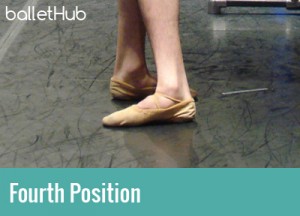Ballet focuses a lot on positions of the body that include the arms, head and legs. In a beginner ballet class there will be a big focus on the basic ballet positions. These include the basic ballet positions of the feet and legs and positions of the arms.
Basic Ballet Positions of the Feet and Legs
There are 4 main basic positions of the feet and legs in ballet. First, second, fourth, and fifth position. You may have noticed that “third position” was left out; this is because its hardly used but we will still cover it as a “bonus” position. All ballet positions of the feet and legs are turned out; this is shown by having the toes pointing away from the middle of the body, to the side. Its important that dancers not just turn out from their feet, but by using their entire leg to rotate outwards so that the knees are pointed in the same direction as the toes. This is known as turnout! Now, let’s get to the positions…
First Position
 First position is a very recognizable basic ballet position. A dancer stands in first position by having the heels of their feet touching (or no more than 2 inches apart for those with hyper-extended legs) with their toes pointing out to the side. Since the feet are even and next to each other, first position can only ever be done one way in terms of the order of your feet.
First position is a very recognizable basic ballet position. A dancer stands in first position by having the heels of their feet touching (or no more than 2 inches apart for those with hyper-extended legs) with their toes pointing out to the side. Since the feet are even and next to each other, first position can only ever be done one way in terms of the order of your feet.
Second Position
 Second position of the feet is very similar to first position, except the dancer now has their heels directly below the outside of their shoulders. The toes are pointed outwards like other positions. This is one of the easiest positions to try for beginners because the distance between the two feet is more common to how most people stand, just now in ballet, its turned out. The feet are again symmetrical in second position, so like first position, there is not another variation in order of the feet to second position.
Second position of the feet is very similar to first position, except the dancer now has their heels directly below the outside of their shoulders. The toes are pointed outwards like other positions. This is one of the easiest positions to try for beginners because the distance between the two feet is more common to how most people stand, just now in ballet, its turned out. The feet are again symmetrical in second position, so like first position, there is not another variation in order of the feet to second position.
Fourth Position
 The basic ballet positions begin to get more complicated with fourth position. In fourth position, a dancer will place one foot in front of the other so there is about a foot or two (depending on height) of distance between the feet. Again, turned out so the toes are pointing to the side and away from the body. Fourth position can have either the left or right foot in front. The toes of the front foot should be in line with the heel of the back foot, which would in turn make the heel of the front foot in line with the toes of the back. Many turns and pirouettes happen from fourth position making it a very important basic ballet position for beginners to advanced professionals.
The basic ballet positions begin to get more complicated with fourth position. In fourth position, a dancer will place one foot in front of the other so there is about a foot or two (depending on height) of distance between the feet. Again, turned out so the toes are pointing to the side and away from the body. Fourth position can have either the left or right foot in front. The toes of the front foot should be in line with the heel of the back foot, which would in turn make the heel of the front foot in line with the toes of the back. Many turns and pirouettes happen from fourth position making it a very important basic ballet position for beginners to advanced professionals.
Fifth Position
 Fifth position is the hardest of all the basic ballet positions. To stand in fifth position, a dancer will have one foot in front of the other but touching while keeping turnout! Like fourth position, the heel of the front foot will be in line with the toes of the back but without any distance between them. Standing in fifth position is difficult (to properly master) because it counts on the dancer to have exceptional turnout that is worked properly from the tops of the legs down into the feet all while keeping the legs straight and in proper alignment. Tons of jumps and turns start and/or end in fifth position, making it a very recognizable position and easily the most common in classical ballet!
Fifth position is the hardest of all the basic ballet positions. To stand in fifth position, a dancer will have one foot in front of the other but touching while keeping turnout! Like fourth position, the heel of the front foot will be in line with the toes of the back but without any distance between them. Standing in fifth position is difficult (to properly master) because it counts on the dancer to have exceptional turnout that is worked properly from the tops of the legs down into the feet all while keeping the legs straight and in proper alignment. Tons of jumps and turns start and/or end in fifth position, making it a very recognizable position and easily the most common in classical ballet!
Third Position
 It seems natural to count from first position, to second position, and then to third position. But why does third position almost always get skipped over? The simple answer: it’s outdated and looks like a mistake. Third position looks like a mid-point between first and fifth. The feet are placed one in front of the other (like fifth) but aren’t completely crossed. In today’s training (and for many decades now) students are taught only fifth position because it is presents technique cleaner. There are never any steps that ask a dancer to start or land in a third position. Because of the difficulty of a clean and proper fifth, it may look like some dancers are in third when they likely aren’t meaning to be. However, third position is still sometimes taught as a basic ballet position to adult students or beginners because it places less strain on the leg muscles. It may also be seen (done purposely) in a classical ballet as part of a character dance or while a male dancer takes his bow.
It seems natural to count from first position, to second position, and then to third position. But why does third position almost always get skipped over? The simple answer: it’s outdated and looks like a mistake. Third position looks like a mid-point between first and fifth. The feet are placed one in front of the other (like fifth) but aren’t completely crossed. In today’s training (and for many decades now) students are taught only fifth position because it is presents technique cleaner. There are never any steps that ask a dancer to start or land in a third position. Because of the difficulty of a clean and proper fifth, it may look like some dancers are in third when they likely aren’t meaning to be. However, third position is still sometimes taught as a basic ballet position to adult students or beginners because it places less strain on the leg muscles. It may also be seen (done purposely) in a classical ballet as part of a character dance or while a male dancer takes his bow.
